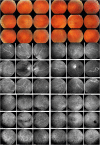Why birdshot retinochoroiditis should rather be called 'HLA-A29 uveitis'?
- PMID: 28314830
- PMCID: PMC5530806
- DOI: 10.1136/bjophthalmol-2016-309764
Why birdshot retinochoroiditis should rather be called 'HLA-A29 uveitis'?
Keywords: Choroid; Immunology; Inflammation; Retina.
Conflict of interest statement
Competing interests: None declared.
Figures



References
Publication types
MeSH terms
Substances
LinkOut - more resources
Full Text Sources
Other Literature Sources
Research Materials
